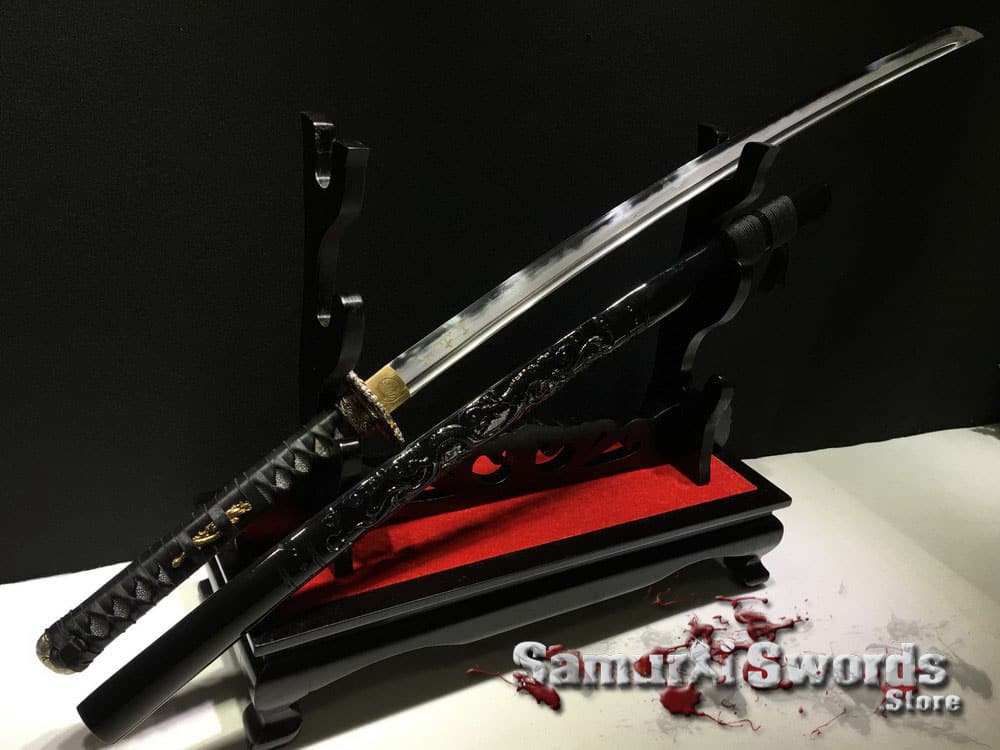Japanese Katana T10 Folded Clay Tempered Steel with Hadori Polish
Japanese Katana made of T10 Folded Clay Tempered Steel with Hadori Polish, High Quality Copper Fittings and Black Engraved Dragon Saya
Sword Type: Katana
Steel Type: T10 Folded Clay Tempered Steel Hadori Polish
Blade Length: 72 Centimeters
Handle Length: 27 Centimeters
Blade Width: 3.2 Centimeters
Weight: 1.62KG
Tang: Full Tang
Sharpness: Sharpened
Blood Groove: With Bohi (Blood Groove)
Tsuba (Handguard): High Quality Copper Tsuba
Fuchi (Hilt Collar): High Quality Copper Fuchi
Kashira (Pommel): High Quality Copper Kashira
Menuki (Handle Ornaments): High Quality Copper Menuki
Saya (Scabbard): Black Engraved Dragon Saya
Ito (Wrap): Authentic Black Leather
Ray Skin (Samegawa): Silver
Sword Bag: Silk
This is a sturdy Japanese Katana with a blade made of T10 steel which is known to be tough and one of the best steels for sword-making. The blade is sharpened, making it a good choice for cutting practice.
The sword’s blade is 1.62 kilograms, and it’s Tsuka is 27 centimeters long. For its blade, the Katana measures 72 centimeters long and 3.2 centimeters wide.
Exceptional Katana Sword
The Katana sword T10 steel is a combination of carbon steel and some Tungsten element which gives it adequate hardnessand resistance to abrasions, making it extremely durable.
Aside from this, the Katana is a full tang and features a Bohi. This keeps the sword lightweight and easier to wield.
The Katana Swords Tsuka Wrap
The handle of this sword is wrapped with a nice black leather Ito. This type of material for the Ito is good since leather is a durable material that is lint and dust-free. Accompanying the black Ito is a genuine Samegawa dyed in silver. It is also strong and durable while adding more to the beauty of the Tsuka.
Quality Fittings
For its fittings, this Katana comes with an HQ copper Tsuba, Menuki, Fuchi, and a Kashira. Its Saya is solid and sturdy, plus it has a nice black engraved dragon +10 on it. The presence of a silk sword bag is also very convenient, especially when you need to carry the sword around.
The First Katana of the Kamakura Period
The term Katana was first mentioned during the Kamakura era from around 1188 – 1333. During that time, the term was often used for describing long blades similar to the Tachi sword.
The Katana, for instance, was longer and less curved than the Tachi. Plus, it was also more powerful and stronger than the latter. The Mongol invasions in Japan led them to change the designs of their Nihonto. This marked the evolution of the Tachi into what would transform into the Katana.
This change continued until the early Muromachi which was from 1337 to 1573. Starting from the year 1400, longer swords with Katana-styled Mei, appeared. The warriors started tp wear their Katana swords with their edge facing up.
Based on tradition, the Samurai would often wear the Nihonto sword with the Mei away from the user. When the wearer carried the Tachi in the Katana style – its cutting edge up – its signature would face the wrong way.
The popularity of the Katana was due to the change in close combat warfare. Quick drawing of the sword was better since victory depended on short response times, in which the Katana is a perfect fit.

